Extracorporeal membrane oxygenation for pediatric respiratory failure: History, development and current status
Extracorporeal membrane oxygenation for pediatric respiratory failure: History, development and current status作者机构:Division of Critical Care Medicine Department of Pediatrics University of UtahSalt Lake City UT 84158 United States
出 版 物:《World Journal of Critical Care Medicine》 (世界重症医学杂志)
年 卷 期:2013年第2卷第4期
页 面:29-39页
学科分类:1002[医学-临床医学] 100202[医学-儿科学] 10[医学]
主 题:Respiratory failure Pediatrics Extracorporeal life support Veno-arterial Veno-venous
摘 要:Extracorporeal membrane oxygenation(ECMO) is currently used to support patients of all ages with acute severe respiratory failure non-responsive to conventional treatments, and although initial use was almost exclusively in neonates, use for this age group is decreasing while use in older children remains stable(300-500 cases annually) and support for adults is increasing. Recent advances in technology include: refinement of double lumen veno-venous(VV) cannulas to support a large range of patient size, pumps with lower prime volumes, more efficient oxygenators, changes in circuit configuration to decrease turbulent flow and hemolysis. Veno-arterial(VA) mode of support remains the predominant type used; however, VV support has lower risk of central nervous injury and mortality. Key to successful survival is implementation of ECMO before irreversible organ injury develops, unless support with ECMO is used as a bridge to transplant. Among pediatric patients treated with ECMO mortality varies by pulmonary diagnosis, underlying condition, other nonpulmonary organ dysfunction as well as patient age, but has remained relatively unchanged overall(43%)over the past several decades. Additional risk factors associated with death include prolonged use of mechanical ventilation( 2 wk) prior to ECMO, use of VA ECMO, older patient age, prolonged ECMO support as well as complications during ECMO. Medical evidence regarding daily patient management specifically related to ECMO is scant, it usually mirrors care recommended for similar patients treated without ECMO. Linkage of the Extracorporeal Life Support Organization dataset with other databases and collaborative research networks will be required to address this knowledge deficit as most centers treat only a few pediatric respiratory failure patients each year.



